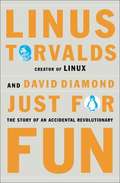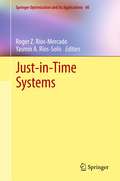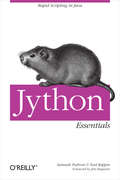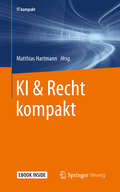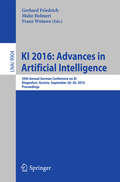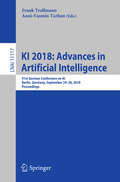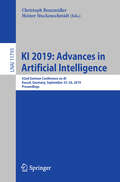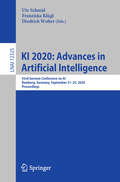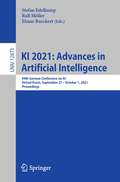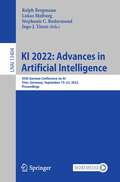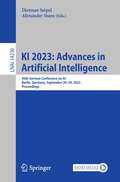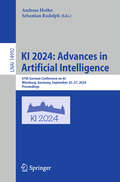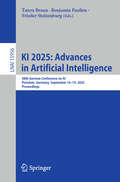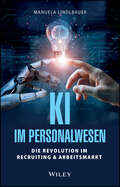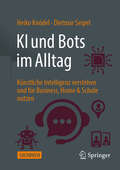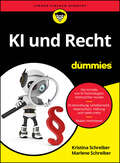- Table View
- List View
Just a Journalist: On the Press, Life, and the Spaces Between (The William E. Massey Sr. lectures in American studies ; #2015)
by Linda GreenhouseA Pulitzer Prize–winning reporter who covered the Supreme Court for The New York Times, Linda Greenhouse trains an autobiographical lens on a moment of transition in U.S. journalism. Calling herself “an accidental activist,” she raises urgent questions about the role of journalists as citizens and participants in the world around them.
Just for Fun: The Story of an Accidental Revolutionary
by Linus Torvalds David DiamondIn a narrative that zips along with the speed of e-mail, Torvalds gives a history of his renegade software while candidly revealing the quirky mind of a genius.
Just-in-Time Systems
by Yasmín A. Ríos-Solís Roger RiosWhether different types of costs are to be reduced, benefits to be maximized or scarce resources to be managed, scheduling theory provides intelligent methods for practitioners and scientists. The just-in-time (JIT) production philosophy has enriched the classical scheduling theory with models that consider characteristics such as inventory costs, set-up times, lot sizing, or maintenance. This edited volume considers the specifics of just-in-time systems. It provides knowledge and insights on recent advances in scheduling theory where just-in-time aspects are considered. Contributions on models, theory, algorithms, and applications, that bring the theory up-to-date on the state-of-the-art of JIT systems are presented. Professionals, researchers and graduate students will find this book useful.
Jython Essentials: Rapid Scripting in Java
by Samuele Pedroni Noel RappinJython is an implementation of the Python programming language written in 100% pure Java, so it runs under any compliant Java Virtual Machine. The secret to Jython's popularity lies in the combination of Java's librariesand tools with Python's rapid development capabilities. With Jython, you can write Python programs that integrate seamlessly with any Java code. And like Python, Jython can be used interactively, so you can get immediate results as you are programming.Jython Essentials provides a solid introduction to the Python language, offering a brief but thorough tour of the Python concepts you'll need to understand to use Jython effectively. The book makes frequent comparisonsbetween Python and Java, with special emphasis on the different object-oriented semantics of the two languages, so Java programmers can quickly get up to speed with Jython.Jython Essentials also covers the various ways in which Jython and Java can interact. For example, Jython code can create instances of pre-existing Java classes and call methods in those instances. You can write Jython classes that are direct subclasses of existing Java classesand use introspection to discern the capabilities of JavaBeans components. This book provides examples of using Jython with existing Java libraries, including the Swing GUI toolkit, the JDBC database API, the Servlet API, and various XML tools. And finally, the book shows howJython can be used as a scripting language within a Java program.With Jython Essentials, you have everything you need to start creating applications that mix the best of Python's interactivity and Java's robust libraries.
KI & Recht kompakt (IT kompakt)
by Matthias HartmannDas Buch gibt einen kompakten Einblick in alle wesentlichen Rechtsfragen rund um den Einsatz Künstlicher Intelligenz in Unternehmen oder Produkten. Versierte Autoren mit Praxiserfahrung erläutern die wichtigsten rechtlichen Themen beim Einsatz intelligenter Systeme und behandeln nach einer Einführung in die technischen Grundlagen die Auswirkungen und Besonderheiten Künstlicher Intelligenz in den Bereichen:ZivilrechtVertragsgestaltungLizenzierung HaftungImmaterialgüterrechte DatenschutzStrafrechtArbeitsrecht
KI 2016: Advances in Artificial Intelligence
by Gerhard Friedrich Malte Helmert Franz WotawaThis book constitutes the refereed proceedings of the 39th Annual German Conference on Artificial Intelligence, KI 2016, in conjunction with the Osterreichische Gesellschaft fur Artificial Intelligence, OGAI, held in Klagenfurt, Austria, in September 2016. The 8 revised full technical papers presented together with 12 technical communications, and 16 extended abstracts were carefully reviewed and selected from 44 submissions. The conference provides the opportunity to present a wider range of results and ideas that are of interest to the KI audience, including reports about recent own publications, position papers, and previews of ongoing work. "
KI 2018: 41st German Conference on AI, Berlin, Germany, September 24–28, 2018, Proceedings (Lecture Notes in Computer Science #11117)
by Anni-Yasmin Turhan Frank TrollmannThis book constitutes the refereed proceedings of the 41st German Conference on Artificial Intelligence, KI 2018, held in Berlin, Germany, in September 2018. The 20 full and 14 short papers presented in this volume were carefully reviewed and selected from 65 submissions. The book also contains one keynote talk in full paper length. The papers were organized in topical sections named: reasoning; multi-agent systems; robotics; learning; planning; neural networks; search; belief revision; context aware systems; and cognitive approach.
KI 2019: 42nd German Conference on AI, Kassel, Germany, September 23–26, 2019, Proceedings (Lecture Notes in Computer Science #11793)
by Heiner Stuckenschmidt Christoph BenzmüllerThis book constitutes the refereed proceedings of the 42nd German Conference on Artificial Intelligence, KI 2019, held in Kassel, Germany, in September 2019. The 16 full and 10 short papers presented together with 3 extended abstracts in this volume were carefully reviewed and selected from 82 submissions. KI 2019 has a special focus theme on "AI methods for Argumentation" and especially invited contributions that use methods from all areas of AI to understand, formalize or generate argument structures in natural language.
KI 2020: 43rd German Conference on AI, Bamberg, Germany, September 21–25, 2020, Proceedings (Lecture Notes in Computer Science #12325)
by Franziska Klügl Ute Schmid Diedrich WolterThis book constitutes the refereed proceedings of the 43rd German Conference on Artificial Intelligence, KI 2020, held in Bamberg, Germany, in September 2020.The 16 full and 12 short papers presented together with 6 extended abstracts in this volume were carefully reviewed and selected from 62 submissions.As well-established annual conference series KI is dedicated to research on theory and applications across all methods and topic areas of AI research. KI 2020 had a special focus on human-centered AI with highlights on AI and education and explainable machine learning. Due to the Corona pandemic KI 2020 was held as a virtual event.
KI 2021: 44th German Conference on AI, Virtual Event, September 27 – October 1, 2021, Proceedings (Lecture Notes in Computer Science #12873)
by Stefan Edelkamp Ralf Möller Elmar RueckertThis book constitutes the refereed proceedings of the 44th German Conference on Artificial Intelligence, KI 2021, held in September/October 2021. Due to COVID-19 pandemic the conference was held virtually. The 16 full and 4 short papers with one extended abstract were carefully reviewed and selected from 59 submissions. As well-established annual conference series KI is dedicated to research on theory and applications across all methods and topic areas of AI research.
KI 2022: 45th German Conference on AI, Trier, Germany, September 19–23, 2022, Proceedings (Lecture Notes in Computer Science #13404)
by Ralph Bergmann Ingo J. Timm Lukas Malburg Stephanie C. RodermundThis book constitutes the refereed proceedings of the 45th German Conference on Artificial Intelligence, KI 2022, held in September 2022.The 12 full and 5 short papers were carefully reviewed and selected from 51 submissions. Additionally, five abstracts of invited talks are included. As well-established annual conference series KI is dedicated to research on theory and applications across all methods and topic areas of AI research.Due to COVID-19 the conference was held virtually.The chapter "Dynamically Self-Adjusting Gaussian Processes for Data Stream Modelling" is available open access under a Creative Commons Attribution 4.0 International License via link.springer.com.
KI 2023: 46th German Conference on AI, Berlin, Germany, September 26–29, 2023, Proceedings (Lecture Notes in Computer Science #14236)
by Dietmar Seipel Alexander SteenThis book constitutes the refereed proceedings of the 46th German Conference on Artificial Intelligence, KI 2023, which took place in Berlin, Germany, in September 2023.The 14 full and 5 short papers presented were carefully reviewed and selected from 78 submissions. The papers deal with research on theory and applications across all methods and topic areas of AI research.
KI 2024: 47th German Conference on AI, Würzburg, Germany, September 25–27, 2024, Proceedings (Lecture Notes in Computer Science #14992)
by Andreas Hotho Sebastian RudolphThis book constitutes the proceedings of the 47th German Conference on AI, KI 2024, which was held in Würzburg, Germany, during September 25–27, 2024. The 19 full papers, 7 short papers and 5 other papers presented in this book were carefully reviewed and selected from 63 submissions. KI is one of the major European AI conferences and traditionally brings together academic and industrial researchers from all areas of AI, providing an ideal place for exchanging news and research results on theory and applications. The papers have been categorized into the following sections: full technical papers; technical communications; extended abstracts of papers from other AI conferences.
KI 2025: 48th German Conference on AI, Potsdam, Germany, September 16–19, 2025, Proceedings (Lecture Notes in Computer Science #15956)
by Frieder Stolzenburg Tanya Braun Benjamin PaaßenThis book constitutes the proceedings of the 48th German Conference on Artificial Intelligence (Künstliche Intelligenz), KI 2025, which was held in Potsdam, Germany, during September 16–19, 2025. The 15 full papers, 8 short papers and 5 extended abstracts presented in these proceedings were carefully reviewed and selected from 74 submissions. They focus on new research results on theory and applications in AI. The papers were categorized in the following sections: Full Technical Papers; Technical Communications; Extended Abstracts.
KI als Zukunftsmotor für Verlage: Potenziale und Fallbeispiele für KI-Anwendungen in der Buchbranche
by Okke SchlüterGenerative KI ist ein Game Changer für Verlage. Wie aber sollten Verlage darauf reagieren? Da in der Publishing-Branche Daten eine wichtige Rolle spielen, können KI-Technologien auch hier wertvolle Beiträge leisten. Diese Innovationen sichern gleichzeitig die Zukunft der Verlagsbranche gegenüber globalen Tech-Konzernen ab, die selbst Publishing anbieten. Ziel des Bandes ist es daher, über konkrete Potenziale in Verlagen zu sprechen, seien es z. B. Manuskriptarbeit, Marketingkommunikation oder Nachauflagen. Mit einer Einführung in KI, drei konkreten Fallbeispielen und einer Potenzialanalyse zu ChatGPT.
KI für das Gute: Künstliche Intelligenz und Ethik
by Stefan H. ViewegWährend die Technologie im Zeitalter des maschinellen Lernens rasant voranschreitet, mangelt es an klaren Absichten und der Formulierung akzeptabler ethischer Standards. Dieses Buch fasst das komplexe Thema der "guten" Technologie bereichsübergreifend zusammen und wechselt zwischen Theorie und Praxis. Die Autoren gehen auf die sich ständig ausweitende Diskussion über Künstliche Intelligenz (KI) und Ethik ein und geben eine Orientierung. Dabei werden insbesondere pragmatische und aktuelle Fragestellungen berücksichtigt, wie z.B. die Kollateralwirkungen der COVID19-Pandemie. Ein aktueller Überblick über die Digitalisierung - an sich schon ein sehr weites Feld - wird ebenso vorgestellt wie eine Analyse der Ansätze von KI aus ethischer Perspektive. Darüber hinaus werden konkrete Ansätze zur Berücksichtigung angemessener ethischer Prinzipien in KI-basierten Lösungen angeboten. Das Buch richtet sich sowohl an Wissenschaftler aus geistes- und wirtschaftswissenschaftlichen oder technischen Disziplinen als auch an Praktiker, die eine Einführung in das Thema und eine Orientierung mit konkreten Fragen und Hilfestellungen suchen.
KI im Mittelstand: Chancen, Optimierungen und Neugeschäft
by Dominik Renner Daniel Reicher Christian VanceaDieses Buch ist ein praktischer Leitfaden, um die Potenziale der Künstlichen Intelligenz (KI) im Mittelstand voll auszuschöpfen. Es bietet sowohl Einsteigern als auch Fortgeschrittenen verständliche Einführungen und fundierte Einblicke. Mit praxisnahen Beispielen, Fallstudien und konkreten Tipps wird gezeigt, wie KI erfolgreich in den Unternehmensalltag integriert werden kann. Ziel ist es, die Komplexität der KI verständlich zu machen und ihren Nutzen für den Mittelstand aufzuzeigen. Ein Muss für alle, die den technologischen Wandel aktiv mitgestalten wollen.
KI in Medien, Kommunikation und Marketing: Wirtschaftliche, gesellschaftliche und rechtliche Perspektiven
by Dominik Pietzcker Christina Vaih-Baur Veit Mathauer Eva-Irina von GammDer Herausgeberband beleuchtet den aktuellen globalen Einsatz von Künstlicher Intelligenz im Kommunikationssektor aus wirtschaftlicher, gesellschaftlicher und rechtlicher Perspektive. Auch der Blick der Rezipienten auf Produkte künstlicher Intelligenz wird dabei empirisch untersucht. Was sind ihre Erwartungen, Idiosynkrasien und Einstellungen gegenüber Künstlicher Intelligenz und ihren vielfältigen Anwendungen? Die Beiträge umfassen neben wissenschaftlichen Analysen auch aktuelle Trends aus Sicht von Praktikern und Experten. Die kritisch-analytische Betrachtung von KI-Anwendungen in Sub- und Populärkultur rundet den gesamten Band ab.
KI in der Psychologie - ist der Mensch eine Maschine? (essentials)
by Peter Gloor Marc SchreiberIm Buch wird die Frage diskutiert, ob der Mensch eine Maschine ist und ob Algorithmen der künstlichen Intelligenz (KI) das menschliche Erleben und Handeln jemals komplett abbilden können werden. Die Fragen werden sowohl aus der Perspektive der Psychologie als auch aus derjenigen der Informatik beleuchtet. Anhand von konkreten Projekten werden die Gemeinsamkeiten und Unterschiede der beiden Perspektiven erläutert und es werden Probleme sowie ethische Fragestellungen im Zusammenhang mit der Anwendung von KI-Algorithmen in psychologischen Anwendungsfeldern thematisiert.
KI in der Radiologie
by Torsten B. Möller Uwe Engelmann Detlef Hans FrankeDie KI verändert die Radiologie derzeit in vielen Bereichen grundlegend. Die Forschung ist schon recht weit fortgeschritten, die praktischen Anwendungen haben jedoch gerade erst flächendeckend begonnen. Internationale radiologische Fachgesellschaften haben sich ebenso wie die EU entschlossen, erste regulatorische Richtlinien zu erlassen und zu veröffentlichen. Deshalb ist dies der richtige Zeitpunkt einen ersten Überblick über die KI in der Radiologie zu geben. Bei einem Thema, das sich so rasant weiterentwickelt wie die KI, ist es ratsam, viele Experten mit speziellen Fachkenntnissen auf ihrem Sektor zu Wort kommen zu lassen. Dies bietet die Möglichkeit, die wichtigsten Facetten der Entwicklung der KI in der Radiologie zu beleuchten. Das Ergebnis ist ein umfassender Überblick, der für alle interessant ist, die sich neu mit dieser Materie beschäftigen, aber auch für andere, die einen tieferen Einblick in die Handhabung der KI in der Radiologie benötigen, sei es auf anwendungsbezogenem, rechtlichem oder organisatorischem Gebiet.
KI und Bots im Alltag: Künstliche Intelligenz verstehen und für Business, Home & Schule nutzen
by Dietmar Seipel Heiko KnödelDas Buch &‘KI und Bots im Alltag&’ bietet fundiertes Fachwissen, vermittelt die Grundlagen der KI ohne technischen Jargon und beleuchtet ihre vielfältigen Anwendungen im Alltag. Ein Kapitel über Ethik und die Zukunft der KI regt zum kritischen Nachdenken an und spiegelt aktuelle Diskussionen wider. Das Buch ist eine wertvolle Ressource für Leser, die sich einen Überblick und ein tieferes Verständnis der KI erschließen möchten. Durch reale Beispiele und praxisnahe Szenarien wird gezeigt, wie tiefgreifend KI das tägliche Leben beeinflusst und gestaltet. Ziel ist es, eine Brücke zwischen der technischen Welt der KI und dem Alltagsverständnis zu schlagen, um ein umfassendes Bild dieser Technologie zu zeichnen.
KI und Recht für Dummies (Für Dummies)
by Kristina Schreiber Marlene SchreiberRechtssicherheit bei der Entwicklung und Nutzung von KI gewinnen Lassen auch Sie sich von KI unterstützen – Content von ChatGPT erstellen, Grafiken von Midjourney gestalten und Fragen von CoPilot beantworten? Oder nutzen Sie schon KI-Modelle in Ihren eigenen Systemen und bieten Kundenservice via Chatbot mithilfe künstlicher Intelligenz an? Haben Sie dabei Datenschutz, Urheberrecht, die Vorgaben der KI-Verordnung und Haftungsfragen im Blick? Dieses Buch erklärt Ihnen verständlich und praxisnah die rechtlichen Aspekte der Nutzung künstlicher Intelligenz und hilft Ihnen dabei, rechtliche Fallstricke zu erkennen und Risiken zu minimieren – damit Sie die Effizienz und Innovationskraft von künstlicher Intelligenz rechtssicher nutzen können! Sie erfahren Was die KI-Verordnung für Ihre Nutzung von KI bedeutet Welche Rolle das Urheberrecht bei der Contenterstellung mit KI spielt Was für das Training von KI-Systemen gilt Wie Sie Chatbots rechtssicher einsetzen
KI und Social Media in der Kulturvermittlung: Eine Einführung (Kunst- und Kulturmanagement)
by Wilfried Zoungrana Jessica Wegelin Achim GroelingDieses Buch untersucht die Potenziale und Herausforderungen der Integration von Künstlicher Intelligenz (KI) und Social Media in der Kulturvermittlung. Es zeigt, wie Museen, Bibliotheken und andere Kulturinstitutionen digitale Technologien wie UX, Chatbots, Gamification, automatisierte Content-Produktion und datenbasierte Social-Media-Strategien im Kontext von KI nutzen können. Im Fokus stehen neue Wege der Zielgruppenansprache, Personalisierung und Teilhabe. Mit Praxisbeispielen und interdisziplinärem Ansatz gibt es Impulse für eine reflektierte und verantwortungsvolle Anwendung.
KI zwischen Ost und West: Ein interdisziplinärer Brückenschlag
by Asadeh Ansari-Bodewein Tim DresslerDer vorliegende Band beleuchtet aktuelle Problemstellungen im Kontext der Entwicklung Künstlicher Intelligenz aus der Perspektive verschiedener akademischer Disziplinen (Philosophie, Sinologie, Informatik, Soziologie) und gibt einen Überblick über den jeweiligen Forschungsstand. Ein besonderes Augenmerk liegt dabei auf der Einbeziehung der sinologischen Perspektive, da China in Europa seit vielen Jahren insbesondere im Zusammenhang mit Diskussionen um die Auswirkungen von KI wahrgenommen wird.

